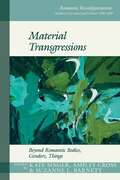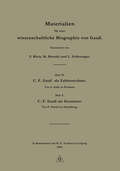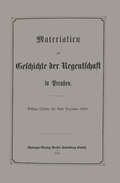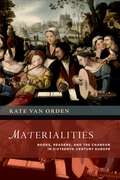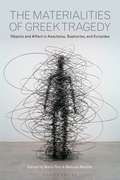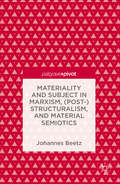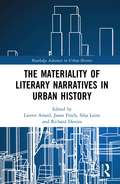- Table View
- List View
Material Transgressions: Beyond Romantic Bodies, Genders, Things (Romantic Reconfigurations: Studies in Literature and Culture 1780-1850 #11)
Material Transgressions reveals how Romantic-era authors think outside of historical and theoretical ideologies that reiterate notions of sexed bodies, embodied subjectivities, isolated things, or stable texts. The essays gathered here examine how Romantic writers rethink materiality, especially the subject-object relationship, in order to challenge the tenets of Enlightenment and the culture of sensibility that privileged the hegemony of the speaking and feeling lyric subject and to undo supposedly invariable matter, and representations of it, that limited their writing, agency, knowledge, and even being. In this volume, the idea of transgression serves as a flexible and capacious discursive and material movement that braids together fluid forms of affect, embodiment, and textuality. The texts explored offer alternative understandings of materiality that move beyond concepts that fix gendered bodies and intellectual capacities, whether human or textual, idea or thing. They enact processes – assemblages, ghost dances, pack mentality, reiterative writing, shapeshifting, multi-voiced choric oralities – that redefine restrictive structures in order to craft alternative modes of being in the world that can help us to reimagine materiality both in the Romantic period and now. Such dynamism not only reveals a new materialist imaginary for Romanticism but also unveils textualities, affects, figurations, and linguistic movements that alter new materialism’s often strictly ontological approach.List of contributors: Kate Singer, Ashley Cross, Suzanne L. Barnett, Harriet Kramer Linkin, Michael Gamer, Katrina O’Loughlin, Emily J. Dolive, Holly Gallagher, Jillian Heydt-Stevenson, Mary Beth Tegan, Mark Lounibos, Sonia Hofkosh, David Sigler, Chris Washington, Donelle Ruwe, Mark Lussier.
Material und Design: Untersuchung zu einem materialorientierten Gestaltungsansatz (Design #42)
by Nico ReinhardtMaterialien sind »gestaltete« Produkte mit spezifischen Eigenschaften und Kontexten. Sie lassen sich phänomenologisch und hermeneutisch interpretieren, um an weiterführende Gestaltungsinformationen zu gelangen. Nico Reinhardt stellt einen »materialorientierten Gestaltungsansatz« im Design vor, indem er das Entwurfsvorhaben ausgehend von Materialien betrachtet und hinterfragt. Das gegensätzliche Eigenschaftspaar »weich/fest« bildet hierbei die verbindende Diskussionsgrundlage. Hierauf aufbauend skizziert er zuerst einen designhistorischen wie -theoretischen Unterbau, um schließlich die Entwicklung eines neuartigen Verbundwerkstoffes aus einer textilarmierten Keramik aufzuzeigen.
Material World: A Substantial Story of Our Past and Future
by Ed ConwayTHE SUNDAY TIMES BESTSELLERTHE TIMES SCIENCE BOOK OF THE YEAR**Shortlisted for the Financial Times Business Book of the Year Award**Picked as a Book of the Year by FINANCIAL TIMES, ECONOMIST and NEW STATESMANA BBC RADIO 4 Book of the Week'A compelling narrative of the human story' TIM MARSHALL, author of Prisoners of Geography'Lively, rich and exciting... full of surprises' PETER FRANKOPAN, author of The Silk Roads_____________Sand, salt, iron, copper, oil and lithium. They built our world, and they will transform our future.These are the six most crucial substances in human history. They took us from the Dark Ages to the present day. They power our computers and phones, build our homes and offices, and create life-saving medicines. But most of us take them completely for granted.In Material World, Ed Conway travels the globe - from the sweltering depths of the deepest mine in Europe, to spotless silicon chip factories in Taiwan, to the eerie green pools where lithium originates - to uncover a secret world we rarely see. Revealing the true marvel of these substances, he follows the mind-boggling journeys, miraculous processes and little-known companies that turn the raw materials we all need into products of astonishing complexity.As we wrestle with climate change, energy crises and the threat of new global conflict, Conway shows why these substances matter more than ever before, and how the hidden battle to control them will shape our geopolitical future. This is the story of civilisation - our ambitions and glory, innovations and appetites - from a new perspective: literally from the ground up.
Materialien für eine wissenschaftliche Biographie von Gauß
by F. Klein M. Brendel L. SchlesingerDieser Buchtitel ist Teil des Digitalisierungsprojekts Springer Book Archives mit Publikationen, die seit den Anfängen des Verlags von 1842 erschienen sind. Der Verlag stellt mit diesem Archiv Quellen für die historische wie auch die disziplingeschichtliche Forschung zur Verfügung, die jeweils im historischen Kontext betrachtet werden müssen. Dieser Titel erschien in der Zeit vor 1945 und wird daher in seiner zeittypischen politisch-ideologischen Ausrichtung vom Verlag nicht beworben.
Materialism
by Terry EagletonA brilliant introduction to the philosophical concept of materialism and its relevance to contemporary science and culture In this eye-opening, intellectually stimulating appreciation of a fascinating school of philosophy, Terry Eagleton makes a powerful argument that materialism is at the center of today’s important scientific and cultural as well as philosophical debates. The author reveals entirely fresh ways of considering the values and beliefs of three very different materialists—Marx, Nietzsche, and Wittgenstein—drawing striking comparisons between their philosophies while reflecting on a wide array of topics, from ideology and history to language, ethics, and the aesthetic. Cogently demonstrating how it is our bodies and corporeal activity that make thought and consciousness possible, Eagleton’s book is a valuable exposition on philosophic thought that strikes to the heart of how we think about ourselves and live in the world.
Materialism from Hobbes to Locke
by Stewart DuncanAre human beings purely material creatures, or is there something else to them, an immaterial part that does some (or all) of the thinking, and might even be able to outlive the death of the body? This book is about how a series of seventeenth-century philosophers tried to answer that question. It begins by looking at the views of Thomas Hobbes, who developed a thoroughly materialist account of the human mind, and later of God as well. This is in obvious contrast to the approach of his contemporary René Descartes. After examining Hobbes's materialism, Stewart Duncan considers the views of three of his English critics: Henry More, Ralph Cudworth, and Margaret Cavendish. Both More and Cudworth thought Hobbes's materialism radically inadequate to explain the workings of the world, while Cavendish developed a distinctive, anti-Hobbesian materialism of her own. The second half of the book focuses on the discussion of materialism in John Locke's Essay concerning Human Understanding, arguing that we can better understand Locke's discussion if we see how and where he is responding to this earlier debate. At crucial points Locke draws on More and Cudworth to argue against Hobbes and other materialists. Nevertheless, Locke did a good deal to reveal how materialism was a genuinely possible view, by showing how one could develop a detailed account of the human mind without presuming it was an immaterial substance. This work probes the thought and debates that originated in the seventeenth-century yet extended far beyond it. And it offers a distinctive, new understanding of Locke's discussion of the human mind.
Materialism from Hobbes to Locke
by Stewart DuncanAre human beings purely material creatures, or is there something else to them, an immaterial part that does some (or all) of the thinking, and might even be able to outlive the death of the body? This book is about how a series of seventeenth-century philosophers tried to answer that question. It begins by looking at the views of Thomas Hobbes, who developed a thoroughly materialist account of the human mind, and later of God as well. This is in obvious contrast to the approach of his contemporary René Descartes. After examining Hobbes's materialism, Stewart Duncan considers the views of three of his English critics: Henry More, Ralph Cudworth, and Margaret Cavendish. Both More and Cudworth thought Hobbes's materialism radically inadequate to explain the workings of the world, while Cavendish developed a distinctive, anti-Hobbesian materialism of her own. The second half of the book focuses on the discussion of materialism in John Locke's Essay concerning Human Understanding, arguing that we can better understand Locke's discussion if we see how and where he is responding to this earlier debate. At crucial points Locke draws on More and Cudworth to argue against Hobbes and other materialists. Nevertheless, Locke did a good deal to reveal how materialism was a genuinely possible view, by showing how one could develop a detailed account of the human mind without presuming it was an immaterial substance. This work probes the thought and debates that originated in the seventeenth-century yet extended far beyond it. And it offers a distinctive, new understanding of Locke's discussion of the human mind.
Materialities: Books, Readers, and the Chanson in Sixteenth-Century Europe (New Cultural History of Music)
by Kate van OrdenEphemeral, fragile, often left unbound, sixteenth-century songbooks led fleeting lives in the pockets of singers and on the music desks of instrumentalists. Constantly in action, they were forever being used up, replaced, or abandoned as ways of reading changed. As such they document the acts of early musicians and the practices of everyday life at the unseen margins of elite society. Materialities is a cultural history of song on the page. It addresses a series of central questions concerning the audiences for written music by concentrating on the first genre to be commercialized by music printers: the French chanson. Scholars have long stressed that chansons represent the most broadly disseminated polyphony of the sixteenth century, but Materialities is the first book to account for the cultural reach of the chanson across a considerable cross-section of European society. Musicologist Kate van Orden brings extensive primary research and new analytical models to bear in this remarkable history of songbooks, music literacy, and social transformation during the first century of music printing. By tracking chansons into private libraries and schoolrooms and putting chansonniers into dialogue with catechisms, civility manuals, and chapbooks, Materialities charts the social distribution of songbooks, the gradual moralization of song, and the ways children learned their letters and notes. Its fresh conclusions revise several common assumptions about the value early moderns attributed to printed music, the levels of literacy required to perform polyphony, and the way musicians did or did not "read" their songbooks. With musical perspectives that can invigorate studies of print culture and the history of reading, Materialities is an essential guide for musicologists working with original sources and historians of the book interested in the vocal performances that operated alongside print.
MATERIALITIES NCHM C: Books, Readers, and the Chanson in Sixteenth-Century Europe (New Cultural History of Music)
by Kate van OrdenEphemeral, fragile, often left unbound, sixteenth-century songbooks led fleeting lives in the pockets of singers and on the music desks of instrumentalists. Constantly in action, they were forever being used up, replaced, or abandoned as ways of reading changed. As such they document the acts of early musicians and the practices of everyday life at the unseen margins of elite society. Materialities is a cultural history of song on the page. It addresses a series of central questions concerning the audiences for written music by concentrating on the first genre to be commercialized by music printers: the French chanson. Scholars have long stressed that chansons represent the most broadly disseminated polyphony of the sixteenth century, but Materialities is the first book to account for the cultural reach of the chanson across a considerable cross-section of European society. Musicologist Kate van Orden brings extensive primary research and new analytical models to bear in this remarkable history of songbooks, music literacy, and social transformation during the first century of music printing. By tracking chansons into private libraries and schoolrooms and putting chansonniers into dialogue with catechisms, civility manuals, and chapbooks, Materialities charts the social distribution of songbooks, the gradual moralization of song, and the ways children learned their letters and notes. Its fresh conclusions revise several common assumptions about the value early moderns attributed to printed music, the levels of literacy required to perform polyphony, and the way musicians did or did not "read" their songbooks. With musical perspectives that can invigorate studies of print culture and the history of reading, Materialities is an essential guide for musicologists working with original sources and historians of the book interested in the vocal performances that operated alongside print.
The Materialities of Greek Tragedy: Objects and Affect in Aeschylus, Sophocles, and Euripides
by Mario Telò Melissa MuellerSituated within contemporary posthumanism, this volume offers theoretical and practical approaches to materiality in Greek tragedy. Established and emerging scholars explore how works of the three major Greek tragedians problematize objects and affect, providing fresh readings of some of the masterpieces of Aeschylus, Sophocles, and Euripides. The so-called new materialisms have complemented the study of objects as signifiers or symbols with an interest in their agency and vitality, their sensuous force and psychosomatic impact-and conversely their resistance and irreducible aloofness. At the same time, emotion has been recast as material “affect,” an intense flow of energies between bodies, animate and inanimate. Powerfully contributing to the current critical debate on materiality, the essays collected here destabilize established interpretations, suggesting alternative approaches and pointing toward a newly robust sense of the physicality of Greek tragedy.
The Materialities of Greek Tragedy: Objects and Affect in Aeschylus, Sophocles, and Euripides
by Mario Telò Melissa MuellerSituated within contemporary posthumanism, this volume offers theoretical and practical approaches to materiality in Greek tragedy. Established and emerging scholars explore how works of the three major Greek tragedians problematize objects and affect, providing fresh readings of some of the masterpieces of Aeschylus, Sophocles, and Euripides. The so-called new materialisms have complemented the study of objects as signifiers or symbols with an interest in their agency and vitality, their sensuous force and psychosomatic impact-and conversely their resistance and irreducible aloofness. At the same time, emotion has been recast as material “affect,” an intense flow of energies between bodies, animate and inanimate. Powerfully contributing to the current critical debate on materiality, the essays collected here destabilize established interpretations, suggesting alternative approaches and pointing toward a newly robust sense of the physicality of Greek tragedy.
Materiality and Devotion in the Poetry of George Herbert
by Francesca CioniGeorge Herbert, his contemporaries, and readers inhabited a world of material things that were spiritually animated but deeply troubling. Habitual providential and typological interpretation imbued matter with meaning, and connected it with the rest of Creation; using material things was an act of interpretation, devotion an act of habitual reading. Materialist philosophies rejected distinctions between body and soul; injunctions to continuous prayer made every place and every bodily motion a potential house of and vehicle for prayer. At the same time Protestant doctrine and Church of England policy, expressed in sermons, visitation articles and works of theology as well as devotional manuals, prayer books and even physiologies and biographies, policed the ways and conditions in which material things, bodies, and spaces might be properly used in devotion. Herbert's Temple is built, read, and used in this world of continual textual and material 'reading'. By a close reading of The Temple, this book explores how Herbert and his readers understood, experienced, and used material objects in devotion. The Temple is an edifice built of paper and ink, of Biblical allusion, and of analogy to both physical churches and spiritual communities of believers: a material and spiritual, literal, and figurative construction. In his verse, Herbert plays with the boundaries between material and spiritual presence, and between literal and figurative signification; in its devotional poetics material and spiritual meanings inform one another and its readers' devotional lives. Materiality and Devotion in the Poetry of George Herbert focuses in turn on three of the most significant kinds of material things seventeenth-century English believers encountered in devotion: their bodies, church buildings, and books.
Materiality and Devotion in the Poetry of George Herbert
by Francesca CioniGeorge Herbert, his contemporaries, and readers inhabited a world of material things that were spiritually animated but deeply troubling. Habitual providential and typological interpretation imbued matter with meaning, and connected it with the rest of Creation; using material things was an act of interpretation, devotion an act of habitual reading. Materialist philosophies rejected distinctions between body and soul; injunctions to continuous prayer made every place and every bodily motion a potential house of and vehicle for prayer. At the same time Protestant doctrine and Church of England policy, expressed in sermons, visitation articles and works of theology as well as devotional manuals, prayer books and even physiologies and biographies, policed the ways and conditions in which material things, bodies, and spaces might be properly used in devotion. Herbert's Temple is built, read, and used in this world of continual textual and material 'reading'. By a close reading of The Temple, this book explores how Herbert and his readers understood, experienced, and used material objects in devotion. The Temple is an edifice built of paper and ink, of Biblical allusion, and of analogy to both physical churches and spiritual communities of believers: a material and spiritual, literal, and figurative construction. In his verse, Herbert plays with the boundaries between material and spiritual presence, and between literal and figurative signification; in its devotional poetics material and spiritual meanings inform one another and its readers' devotional lives. Materiality and Devotion in the Poetry of George Herbert focuses in turn on three of the most significant kinds of material things seventeenth-century English believers encountered in devotion: their bodies, church buildings, and books.
Materiality and Subject in Marxism, (Post-)Structuralism, and Material Semiotics
by Johannes BeetzIn recent decades, what is known as 'the subject' has been problematized by various old and new materialisms and today appears as decentered in and by language, split by the unconscious, deformed by social forces, governed by ideology and is either seen to have succumbed to the postmodern condition or to never have existed in the first place. Every materialist theory of the subject depends on a conception of materiality, which can delineate the character of what the material reality, which de-centers or constitutes the subject consists of. Materiality and Subject in Marxism, (Post-)Structuralism, and Material Semiotics investigates the relation between materiality and the subject in the materialist approaches of Marxism, (post-)structuralism, and material semiotics. None of these approaches subscribes to a reductionist materialism; rather, they conceive of materiality as multiple, complex, and not reducible to tangible matter. For each approach, the modalities of materiality of the respective materialism are defined. The relationship between the multiple materialities and the subject constituted and decentered in this relationship are presented as specific to the theoretical approaches discussed.
A Materiality of Internment (ISSN)
by Gilly CarrMore than two thousand people from the British Channel Islands were deported to and interned in Germany during the Second World War, making up as many as 60% of all interned British citizens in occupied territory during this period.This book carries out an in-depth analysis of artwork, objects, oral testimonies, archives, poetry, letters, diaries and memoirs gathered from the internees and drawing from around one hundred collections. The work is based on over 15 years of research and interviews with more than 65 former internees, and explores analytical themes and narratives of placemaking, resistance, communities, food and cooking. It also proposes new concepts and categories to help us understand objects that distinguish the experience of internment.This book will be of great value for scholars and museum professionals, as well as postgraduate students in the field of Conflict Archaeology and scholars of the Second World War. Cumulatively, this materiality comprises one of the major surviving assemblages of internees to emerge from the war, comparable in size, quality and importance with that from other theatres of war.
A Materiality of Internment (ISSN)
by Gilly CarrMore than two thousand people from the British Channel Islands were deported to and interned in Germany during the Second World War, making up as many as 60% of all interned British citizens in occupied territory during this period.This book carries out an in-depth analysis of artwork, objects, oral testimonies, archives, poetry, letters, diaries and memoirs gathered from the internees and drawing from around one hundred collections. The work is based on over 15 years of research and interviews with more than 65 former internees, and explores analytical themes and narratives of placemaking, resistance, communities, food and cooking. It also proposes new concepts and categories to help us understand objects that distinguish the experience of internment.This book will be of great value for scholars and museum professionals, as well as postgraduate students in the field of Conflict Archaeology and scholars of the Second World War. Cumulatively, this materiality comprises one of the major surviving assemblages of internees to emerge from the war, comparable in size, quality and importance with that from other theatres of war.
The Materiality of Literary Narratives in Urban History (Routledge Advances in Urban History)
by Lieven Ameel Jason Finch Silja Laine Richard DennisThe Materiality of Literary Narratives in Urban History explores a variety of geographical and cultural contexts to examine what literary texts, grasped as material objects and reflections on urban materialities, have to offer for urban history. The contributing writers’ approach to literary narratives and materialities in urban history is summarised within the conceptualisation ‘materiality in/of literature’: the way in which literary narratives at once refer to the material world and actively partake in the material construction of the world. This book takes a geographically multipolar and multidisciplinary approach to discuss cities in the UK, the US, India, South Africa, Finland, and France whilst examining a wide range of textual genres from the novel to cartoons, advertising copy, architecture and urban planning, and archaeological writing. In the process, attention is drawn to narrative complexities embedded within literary fiction and to the dialogue between narratives and historical change. The Materiality of Literary Narratives in Urban History has three areas of focus: literary fiction as form of urban materiality, literary narratives as social investigations of the material city, and the narrating of silenced material lives as witnessed in various narrative sources.
The Materiality of Literary Narratives in Urban History (Routledge Advances in Urban History)
by Lieven Ameel Jason Finch Silja Laine Richard DennisThe Materiality of Literary Narratives in Urban History explores a variety of geographical and cultural contexts to examine what literary texts, grasped as material objects and reflections on urban materialities, have to offer for urban history. The contributing writers’ approach to literary narratives and materialities in urban history is summarised within the conceptualisation ‘materiality in/of literature’: the way in which literary narratives at once refer to the material world and actively partake in the material construction of the world. This book takes a geographically multipolar and multidisciplinary approach to discuss cities in the UK, the US, India, South Africa, Finland, and France whilst examining a wide range of textual genres from the novel to cartoons, advertising copy, architecture and urban planning, and archaeological writing. In the process, attention is drawn to narrative complexities embedded within literary fiction and to the dialogue between narratives and historical change. The Materiality of Literary Narratives in Urban History has three areas of focus: literary fiction as form of urban materiality, literary narratives as social investigations of the material city, and the narrating of silenced material lives as witnessed in various narrative sources.
The Materiality of Terracotta Sculpture in Early Modern Europe (Routledge Research in Art History)
by Zuzanna Sarnecka Agnieszka DzikiThrough meticulously researched case studies, this book explores the materiality of terracotta sculpture in early modern Europe. Chapters present a broad geographical perspective showcasing examples of modelling, firing, painting, and gilding of clay in Portugal, Spain, Italy, Germany, and the Netherlands. The volume considers known artworks by celebrated artists, such as Luca della Robbia, Andrea del Verrocchio, Filipe Hodart, or Hans Reichle, in parallel with several lesser-studied terracotta sculptures and tin-glazed earthenware made by anonymous artisans. This book challenges arbitrary distinctions into the fine art and the applied arts, that obscured the image of artistic production in the early modern world. The centrality of clay in the creative processes of artists working with two- and three-dimensional artefacts comes to the fore. The role of terracotta figures in religious practices, as well as processes of material substitutions or mimesis, confirm the medium’s significance for European visual and material culture in general. This book will be of interest to scholars working in art history, Renaissance studies, and material culture.
The Materiality of Terracotta Sculpture in Early Modern Europe (Routledge Research in Art History)
by Zuzanna Sarnecka Agnieszka DzikiThrough meticulously researched case studies, this book explores the materiality of terracotta sculpture in early modern Europe. Chapters present a broad geographical perspective showcasing examples of modelling, firing, painting, and gilding of clay in Portugal, Spain, Italy, Germany, and the Netherlands. The volume considers known artworks by celebrated artists, such as Luca della Robbia, Andrea del Verrocchio, Filipe Hodart, or Hans Reichle, in parallel with several lesser-studied terracotta sculptures and tin-glazed earthenware made by anonymous artisans. This book challenges arbitrary distinctions into the fine art and the applied arts, that obscured the image of artistic production in the early modern world. The centrality of clay in the creative processes of artists working with two- and three-dimensional artefacts comes to the fore. The role of terracotta figures in religious practices, as well as processes of material substitutions or mimesis, confirm the medium’s significance for European visual and material culture in general. This book will be of interest to scholars working in art history, Renaissance studies, and material culture.
The Materiality of the Archive: Creative Practice in Context (Routledge Studies in Archives)
by Sue Breakell Wendy RussellThe Materiality of the Archive is the first volume to bring together a range of methodological approaches to the materiality of archives, as a framework for their engagement, analysis and interpretation. Focusing on the archives of creative practices, the book reaches between and across existing bodies of knowledge in this field, including material culture, art history and literary studies, unified by an interest in archives as material deposits and aggregations, in both analogue and digital forms, as well as the material encounter. Connecting a breadth of disciplinary interests in the archive with expanding discourses in materiality, contributors address the potential of a material engagement to animate archival content. Analysing the systems, processes and actions that constitute the shapes, forms and structures in which individual archival objects accumulate, and the underpinnings which may hold them in place as an archival body, the book considers ways in which the inexorable move to the digital affects traditional theories of the physical archival object. It also considers how stewardship practices such as description and metadata creation can accommodate these changes. The Materiality of the Archive unifies theory and practice and brings together professional and academic perspectives. The book is essential reading for academics, researchers and postgraduate students working in the fields of archive studies, museology, art history and material culture.
The Materiality of the Archive: Creative Practice in Context (Routledge Studies in Archives)
The Materiality of the Archive is the first volume to bring together a range of methodological approaches to the materiality of archives, as a framework for their engagement, analysis and interpretation. Focusing on the archives of creative practices, the book reaches between and across existing bodies of knowledge in this field, including material culture, art history and literary studies, unified by an interest in archives as material deposits and aggregations, in both analogue and digital forms, as well as the material encounter. Connecting a breadth of disciplinary interests in the archive with expanding discourses in materiality, contributors address the potential of a material engagement to animate archival content. Analysing the systems, processes and actions that constitute the shapes, forms and structures in which individual archival objects accumulate, and the underpinnings which may hold them in place as an archival body, the book considers ways in which the inexorable move to the digital affects traditional theories of the physical archival object. It also considers how stewardship practices such as description and metadata creation can accommodate these changes. The Materiality of the Archive unifies theory and practice and brings together professional and academic perspectives. The book is essential reading for academics, researchers and postgraduate students working in the fields of archive studies, museology, art history and material culture.
Materializing Bakhtin: The Bakhtin Circle and Social Theory (St Antony's Series)
by C. Brandist G. TihanovThis volume brings together nine essays by established and new scholars from Russia, Britain and North America to explore the historical contexts and current relevance of the work of the Bakhtin Circle for social theory, philosophy, history and linguistics.
Materializing Europe: Transnational Infrastructures and the Project of Europe
by Alexander Badenoch & Andreas FickersThis book explores the relationships between European integration and material infrastructures. Taking transnational infrastructures as the focal point of study, the book focuses on the various forms of mediation between the material, institutional and discursive levels of European integration and fragmentation in a truly transnational perspective.
